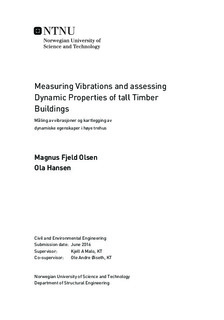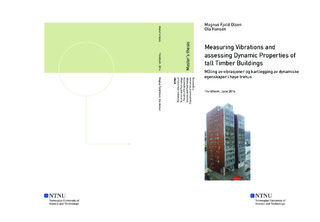| dc.description.abstract | The main goal behind this thesis is to evaluate the dynamic properties of the worlds
tallest timber building, Treet, in Bergen. The dynamic properties will be extracted from recorded acceleration time series. Measurements will also be acquired and evaluated for Moholt 50|50, a new student housing project initiated by Studentsamskipnaden i Trondheim.
Acceleration measurements are performed using accelerometers from Kistler, PCB Piezotronics, and data acquisition hardware from National Instruments. The Acceleration data is then processed using a method called Covariance-Driven Stochastic Subspace Identification. From this method the natural frequencies, mode shapes and damping ratios are extracted. These parameters are then compared to the results from numerical models and engineering assumptions that were made during the planning of the respective buildings. An evaluation of the maximum accelerations and displacements is also performed. Finally, a numerical model of Moholt 50|50 is created in Abaqus/CAE in order to investigate how a numerical model for this type of structure predicts dynamic behaviour.
Results obtained from the measurements show that the engineers responsible for predicting the dynamic behaviour of Treet were satisfactory close to actual properties, although the natural frequencies seem to be consistently higher due to non-structural effects. The measured dynamic properties at Moholt 50|50 were close to the Natural frequencies and mode shapes predicted by the numerical model. However, it is unknown whether the responsible engineers predicted the same results. Also, the damping ratios at Moholt are highly uncertain due to the excitation system not coinciding well With the white noise assumption used for Operational Modal Analysis. | |

